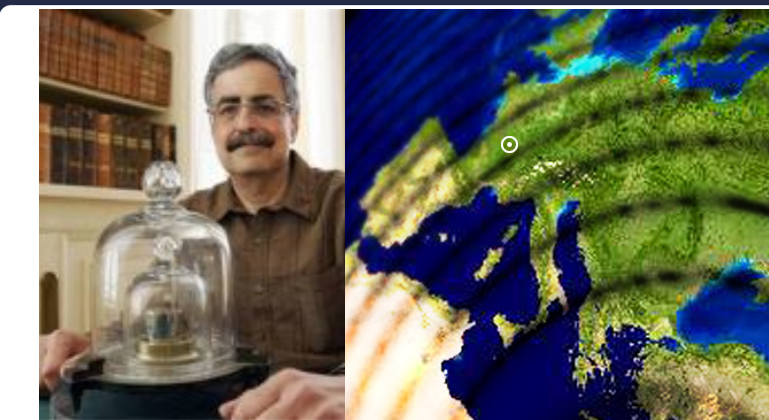Acoustic Levitation of the Kilogram Measure
Shrinking Kilogram Bewilders Physicists
by Jamey Keaten for AP
September 12, 2007
Physicist Richard Davis of the International Bureau of Weights and Measures, sits next to a copy of a 118-year-old cylinder that has been the international prototype for the metric mass, in his office in Sevres, southwest of Paris, Wednesday, Sept. 12, 2007. Davis said the reference kilo appears to have lost 50 micrograms compared to the average of dozens of copies. The kilogram's inconstancy illustrates how technological progress is leaving science's most basic measurements in its dust.
A kilogram just isn't what it used to be. The 118-year-old cylinder that is the international prototype for the metric mass, kept tightly under lock and key outside Paris, is mysteriously losing weight - if ever so slightly.
Physicist Richard Davis of the International Bureau of Weights and Measures in Sevres, southwest of Paris, says the reference kilo appears to have lost 50 micrograms compared with the average of dozens of copies.
"The mystery is that they were all made of the same material, and many were made at the same time and kept under the same conditions, and yet the masses among them are slowly drifting apart," he said. "We don't really have a good hypothesis for it."
The kilogram's uncertainty could affect even countries that don't use the metric system - it is the ultimate weight standard for the U.S. customary system, where it equals 2.2 pounds. For scientists, the inconstant metric constant is a nuisance, threatening calculation of things like electricity generation.
"They depend on a mass measurement and it's inconvenient for them to have a definition of the kilogram which is based on some artifact," said Davis, who is American.
But don't expect the slimmed-down kilo to have any effect, other than possibly envy, on wary waistline-watchers: 50 micrograms is roughly equivalent to the weight of a fingerprint.
"For the lay person, it won't mean anything," said Davis. "The kilogram will stay the kilogram, and the weights you have in a weight set will all still be correct."
Of all the world's kilograms, only the one in Sevres really counts. It is kept in a triple-locked safe at a chateau and rarely sees the light of day - mostly for comparison with other cylinders shipped in periodically from around the world.
"It's not clear whether the original has become lighter, or the national prototypes have become heavier," said Michael Borys, a senior researcher with Germany's national measures institute in Braunschweig. "But by definition, only the original represents exactly a kilogram."
The kilogram's fluctuation shows how technological progress is leaving science's most basic measurements in its dust. The cylinder was high-tech for its day in 1889 when cast from a platinum and iridium alloy, measuring 1.54 inches in diameter and height.
At a November meeting of scientists in Paris, an advisory panel on measurements will present possible steps toward basing the kilogram and other measures - like Kelvin for temperature, and the mole for amount - on more precise calculations. Ultimately, policy makers from around the world would have to agree to any change.
Many measurements have undergone makeovers over the years. The meter was once defined as roughly the distance between scratches on a bar, a far cry from today's high-tech standard involving the distance that light travels in a vacuum.
One of the leading alternatives for a 21st-century kilogram is a sphere made out of a Silicon-28 isotope crystal, which would involve a single type of atom and have a fixed mass.
"We could obviously use a better definition," Davis said.
Analysis
It seems that the recent physics discoveries of acoustic levitation have not been considered
by any of the investigators of these anomalies. The resonance of earth is now shifting, and strengthening levels of inaudible infrasound are altering the planet's gravity field in concentric resonant rings. This inevitably results in the ambient acoustic levitation of objects in specific places, as physically described in the equations of physicist De Aquino. This same effect is causing huge boulders to levitate into treetops in both Yellowwood and Limon Indiana State Parks.
In Sevres, France, outside Paris, the ambient levels of infrasound are subtly lessening the weight of the Kg measure studied by Dr. Davis. The weight is composed of a platinum-iridium alloy that is paramagnetic, meaning it is slightly effected by the magnetic fields being transduced by the piezoelectric bedrock of the area (from infrasound into a magnetic field). Other Kg weights are measuring differently due to differing ambient infrasound levels in their respective locations, which variably cancels the force of gravity. This can be easily proven by artificially increasing the incident infrasound levels and measuring the weightloss.
Sevres, France (48.82N 2.20E) is 2,001 miles from the deeply humming Giza pyramids, a distance that is 8.0% of the earth's circumference. This same effect of lessened gravity by focused infrasound was employed in the construction and design function of Stonehenge, an ancient sacred site that sits at 9.0% of the earth's circumference from the Giza pyramids.
Such unusual acoustic levitation is a sign that a new resonance is emerging in Sevres, and will be building gradually into a higher energy level
that has already been observed at other infrasound focal points. Extreme manifestations of this resonance are waves of piezoelectric fires that are now
simultaneously occuring in Ratria, India,
Messina, Italy, Bodibe, South Africa and Santa Barbara, USA.





